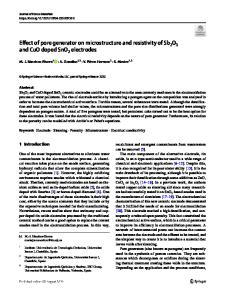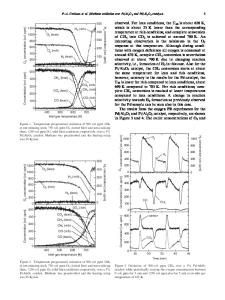Effect of Shell Pore Microstructure of the Pd Hollow Catalysts Pd@HMAN for H 2 O 2 Generation
- PDF / 1,484,057 Bytes
- 10 Pages / 595.276 x 790.866 pts Page_size
- 81 Downloads / 252 Views
Effect of Shell Pore Microstructure of the Pd Hollow Catalysts Pd@ HMAN for H2O2 Generation Dan Guo1,3 · Jiesong Zhang2 · Shen Xiao2 · Lianjun Shi1,2 · Qian Lin2 · Hongyan Pan1,2,3 Received: 4 February 2020 / Accepted: 3 September 2020 © Springer Science+Business Media, LLC, part of Springer Nature 2020
Abstract Pd-based hollow catalysts, Pd@HMAN, in which Pd was used as core and hollow aluminosilicate (HMAN) as shell, have been successfully synthesized by self-assembling method. Pd@HMAN-M (M = 1, 1.5, 2, 2.5) with uniform Pd nanoparticle size (~ 9.3 nm) and different shell volume (0.06–0.18 c m3g−1) were prepared by varying the addition amount of tetraethyl orthosilicate (TEOS). It is found that the shell pore size of 1–3.5 nm of the catalysts Pd@HMAN-M was conducive to the mass transfer of H2, O2 and H2O2, and the larger the shell pore volume of Pd@HMAN-M was, the larger the adsorption amount of reactant H2 was, and thus the higher selective and productive of H2O2 could be obtained. The catalyst [email protected] had the highest H2O2 selectivity (81%) and productivity (795 mmol gPd−1 h−1) at atmospheric pressure due to its most substantial shell pore volume of (0.18 cm3g−1) and H2 adsorption amount. Graphic Abstract
Keywords Pd hollow catalysts · Shell pore size · Shell pore volume · Direct synthesis of H2O2
1 Introduction
* Qian Lin [email protected] Extended author information available on the last page of the article
As H2O being its only byproduct, H2O2 is considered to be the most eco-friendly oxidant/detergent, and is widely applied in industries such as pulp bleaching and deinking, wastes control, semiconductor cleaning, and soil repair [1].
13
Vol.:(0123456789)
Today, the method to produce H2O2 in industry is anthraquinone autoxidation process (AO process), whereas, it can produce unwanted wastes and higher operating costs. Compared with AO process, the direct formation of H2O2 from H2 and O2 on the Pd based catalyst undoubtedly has the advantages of simpler process, milder operation conditions (normal pressure and normal/low temperature), lower operating cost and no pollution (water and methanol are usually used as reaction medium) [2]. Nevertheless, this process, so far, cannot achieve industrial production because of its lower selectivity and yield of H 2O2. This can be further explained as follows: (1) O–O bond of H 2O2 and O 2 are likely to be dissociated on active component Pd surface, which produce H2O instead of H2O2 [3]. (2) utilization rate of H2–H2O2 is relative lower because H 2 accumulation amount on Pd surface is smaller due to its lower solubility and adsorption amounts [4, 5]. Freakley et al. [6] pointed out that even if H2O2 selectivity reached 96% for the catalysts Pd–Sn/TiO2, its H2 conversion rate was merely about 9%. Lee et al. [7] found that despite of an over 90% conversion rate of H2, H2O2 selectivity was limited to about 8% as the result of the severe side reactions of hydrogenation and H 2O2 decomposition. In summary, improving both the
Data Loading...











